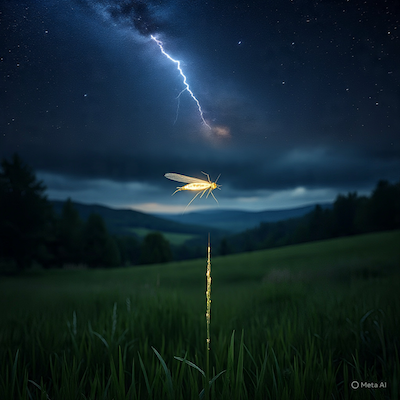The Smallest Tick of Time — a Glimpse of Wonder entry™ —
 A lightning bug drifts low over the grass, its glow blinking on and off like a lantern guided by an unseen hand. It hovers for a moment, then dips and lands on a leaf. Another spark, then a slow float to a nearby blade of grass. Another blink, another drift, as though the whole meadow breathes with its rhythm. Glitter and float. Glitter and float.
A lightning bug drifts low over the grass, its glow blinking on and off like a lantern guided by an unseen hand. It hovers for a moment, then dips and lands on a leaf. Another spark, then a slow float to a nearby blade of grass. Another blink, another drift, as though the whole meadow breathes with its rhythm. Glitter and float. Glitter and float.
In the distance, a storm gathers. The horizon flickers with lightning, far off at first, just a flash at the edge of the sky. The firefly glows again, softer than a heartbeat. Glitter and float. But the storm moves closer. A brighter flash, then another. Thunder rolls low. Soon the sky itself crackles, the great strokes of lightning overwhelming the little light. The firefly is gone, swallowed in the storm.
And this is where our story begins — with a flash. Not of summer lightning, but of the entire universe itself. Scientists call it the Big Bang theory.
The theory does not describe the instant of the bang.
That moment — time zero — lies beyond our reach.
The Big Bang theory begins after it.
It starts with the first measurable sliver of time.
The threshold is unimaginably small.
But from there onward, physics can speak with clarity.
This boundary is called the Planck time.
A short detour — the story of the number
The Planck time lasts about 10⁻⁴³ seconds. Written out, that’s a decimal point, forty-two zeros, and then a one. Numbers that small are awkward to name. A tenth is 0.1. A hundredth is 0.01. A thousandth is 0.001. Follow the pattern: each extra zero takes you deeper into the tiny. By the time you’ve reached forty-two zeros, you are staring at one ten-duo-trigintillionth (TEN-doo-oh-try-JIN-til-ee-uhnth) of a second. A name that stretches language itself to the breaking point. For that reason, scientists simply call it “ten to the minus forty-three.” Easier to say, but no less staggering to imagine.
Why does it matter? Because before this instant, our equations fail. General relativity explains the grand sweep of galaxies, quantum mechanics explains the subatomic flickers — but at the Planck time the two collide. The math collapses. Human physics stops working. We cannot say what happened before.
But from the Planck time forward, the Big Bang theory holds. Evidence falls into place like pieces of a puzzle: the faint glow of the cosmic microwave background, the proportions of hydrogen and helium written into the stars, the rippling pattern of galaxies across the heavens. Not one find, but many. Together they sing the same story — that the universe has a beginning, and that from this smallest measurable instant, its growth can be traced with astonishing reliability.
Yet Scripture goes further. It speaks of the One who was already there before time itself began. “From everlasting to everlasting you are God,” says Psalm 90:2. And verse 4 adds, “For a thousand years are in your eyes just like yesterday when it is past” (NWT). Jehovah is not bound by seconds, millennia, or Planck times. He created them all. He stands outside the limits of our equations, not just initiating matter and energy, but calling time itself into existence.
Every Glimpse of Wonder™ is just that — a flicker. Tinier than a firefly’s glow, tinier even than a ten-duo-trigintillionth of a second. And yet each flicker is enough. Enough to remind us of the greatness of Jehovah’s creation, and of the timeless One who holds both the smallest instant and eternity itself in his hands.
- dilip kumar, Dolce vita and Roxessence
-
 1
1
-
 1
1
-
 1
1

2 Comments
Recommended Comments
Join the conversation with your brothers and sisters!
You are posting as a guest. If you are already a member, sign in now to post with your existing account.
Note: Your post will require moderator approval before it will be visible.